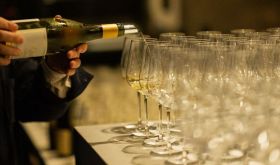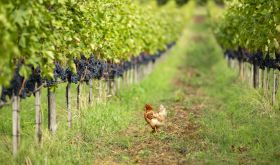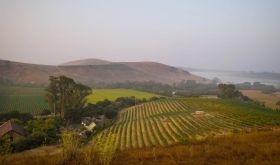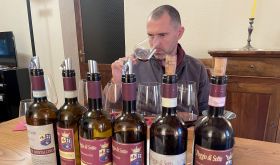Kelly Liang writes Kelly Liang fell into the strange but fascinating world of wine after working in academia, non-profit and tech. Her dream is to travel the world through harvests while tasting great wines, meeting fun people and collecting unique stories. She already has two harvests under her belt. Many more to go.
Vines of Time: Chris Tyrrell and the Hunter Valley’s Winemaking Heritage
Harvest is awesome. It’s the most magical time of the year. Feel the sun, wind and rain crystallising into translucent grapes that glow in your hands. Taste their freshly pressed juice. Listen to them singing away in the fermentation tanks, and imagine how the vintage will turn out. So different from the desk where I spend the other 11 months of the year!
I did my 2023 vintage at Tyrrell’s, the oldest family winery in the Hunter Valley, where I had the honour of working with inspiring people like Chris.
Chris is the youngest of Tyrrell’s fifth generation and the torchbearer of a winemaking heritage that predates the federation of Australia. The last time I saw him during the harvest, he was on a forklift loading a bin of hand-harvested Chardonnay destined for Tyrrell’s acclaimed Vat 47.
Towering over six feet tall, Chris has an unforgettable laugh, loud and resonant enough that it fills every crack in the old winery’s earthen floor. Outside of this old winery, a rusty slab hut sits on top of the vineyard’s gently rolling hills. No longer inhabited, the hut was a favourite hide-and-seek spot for Chris and his siblings, Jane and John. And it was in this old hut that Edward Tyrrell, Chris’s great-great-grandfather, ate and slept when he planted the first vinifera vines in 1858.
Edward was a fortunate man: he received one of the last land grants in central Pokolbin, which was home to the Wonnarua people before the first European settlers arrived. Little did he know that this 300-acre plot of red and yellow dirt would one day yield Australia’s most renowned Semillon, Chardonnay and Shiraz.
By the time Chris' great-great-grandfather arrived in Pokolbin, many families had been making fortified wines for the local miners for decades. Among them were the Lindemans, Wyndhams, Wilkinsons, Kelmans, and Kings.
Where are these great winemaking families now? Most of them have severed their roots in the Hunter Valley, while the Tyrrells have managed to hold their ground.
After surviving the post-federation flood of cheap South Australian wines, Lindeman’s Wines ran into cash flow issues in the 1930s and was sold to the US-based tobacco giant Philip Morris, then Penfolds, and eventually became an entry-level brand in the Treasury Group’s vast portfolio. Lindeman’s once produced some of the best Semillons of all time: Bin 1616 in 1961 and Bin 2510 in 1964. Today, this once legendary winery attracts tasters with Penfolds Grange, a Shiraz made thousands of miles away in the Barossa Valley, South Australia.
Unlike Lindeman’s decline, Wyndham Estate is nowhere to be found in the Hunter Valley. Many refer to their famous Dalwood vineyard as the Hunter Valley’s first commercial vine plantings. This historic vineyard and the Wyndham name have changed hands among big players over the years: Penfolds, Pernod Ricard and McGuigan.
As for the McGuigan family, they had ambitions that spread beyond Pokolbin. Starting as a cellar hand at Dalwood Estate, Percival McGuigan worked his way up to become its chief winemaker. When Penfolds exited the valley in 1968, Percival bought it for a modest $12,000, not knowing that one day his son, Brian, would turn it into a multi-million dollar enterprise producing throughout Australia. 2022 marked the final vintage McGuigan ever made in the Hunter Valley, its birthplace.
Chris grew up witnessing these changes. There were only a couple of dozen wineries and one local store when he was a child. By the time he finished high school and worked his first vintage at Tyrrell’s, he found he had some new neighbours: resorts, golf courses, and even an Irish pub. The Hunter Valley was slowly turning into a popular weekend destination for Sydneysiders.
On a sunny, seemingly ordinary day at the start of the 2008 harvest, a fermentation tank exploded at Drayton’s Family Winery, tragically taking the life of the owner and winemaker, Trevor Drayton. Chris didn’t know it at the time, but this marked the end of an era for the Hunter.
Chris and his father, Bruce, coordinated with fellow winery owners to ensure that Drayton’s fruit was picked and processed promptly at different wineries across the valley. Everyone wanted the Draytons, an anchor and icon of the Hunter Valley wine industry since 1853, to still have a vintage in 2008.
Over the next decade, the Draytons grappled with filling the void Trevor left behind, eventually selling the family winery and vineyards in 2022. Out went another old family winery, leaving Tyrrell’s as the only one that has been making wine on the same land through times of war, depression and massive societal change, from the colonial settler era right into this digital age.
This was just part of the broader trend unfolding in the Hunter Valley. New money and corporations moved in, turning vineyards into concert grounds, resorts, galleries and wedding venues. Many family wineries found themselves with little choice but to sell.
At Tyrrell’s, Chris kept grinding. He knew the only way to keep his family’s heritage alive and thriving was to master the business and improve it. Chris rotated around Tyrrell’s Sydney office and Pokolbin winery, learning first hand the different aspects of making wine – logistics, business management, marketing, and customer experience.
Slowly but surely, he found his voice, even in the winery lab fondly called the “war room”. This small room was a place where Chris had to contribute as an equal to his father, winemakers, and viticulturists about when and what to harvest. This was no easy task. As the youngest person in the room, Chris had, until recently, lived fewer years than the number of vintages Andrew Spinaze, Tyrrell’s king of Semillon, had accomplished.
When I asked Chris about his vision for Tyrrell’s, he shrugged and said, “Pretty much just continue doing what my grandfather was doing.” Patience and humility are Chris’ strong suit. He knows that all great things take time – time on the scale of generations.
His grandfather, Murray, was a visionary. He not only revived single varietal Chardonnay in Australia but also introduced the Vat series. Murray wanted to showcase the unique ungrafted old vines from the original James Busby clones that the Tyrrells had nurtured since the 19th century.
Chris’ father, Bruce, went a step further and created the single vineyard line for Semillon and Shiraz to bring terroir to the foreground. Now, Chris focuses on accessing and improving historic vineyards across the Hunter Valley. He will take these dry-farmed ancient vines to the world stage.
Some of these sites have not always been part of Tyrrell’s. Many were planted by famous names like the Elliots, Draytons, and Stevens, all of whom have left incredible marks in the Valley’s history. The next time you see Tyrrell’s slogan “We are Hunter Valley” in bottle shops, give it a second thought!
So, how does Chris feel about the Tyrrells being the oldest family-run winery in the Hunter Valley?
“There are always new families joining the Valley, and they’re making great wines,” Chris explained with a broad grin.
Indeed, the Hunter Valley today is blessed with many committed family wineries. To name but a few: the Eathers of Meerea Park, who strive to restore the glory of their ancestor Alexander Munro; the De Iuliises, who introduced Touriga Nacional to the valley; Andrew Thomas, who left his McLaren Vale home to perfect Hunter Semillons and Shirazes; and the Margans, who are redefining the subregion Broke through regenerative viticulture.
Does it surprise you that many of this new generation of winemaking families started off growing grapes or making wines for Tyrrell’s?
Next to Chris’s house lies a very special plot of Shiraz vines. Planted around 2010, these vines are the jewels of mass-selection from Tyrrell’s best old vineyards and grafted onto phylloxera-resistant rootstocks. Chris affectionately named this vineyard “Mother’s” for its role in protecting Tyrrell’s viticultural heritage over the next 150 years.
Now I’m back home in England and ten thousand miles away from Mother’s and Tyrrell’s other unique vineyards, I still feel very much connected to them. Chris is highly visible on social media, ensuring that Tyrrell’s never falls into obscurity.
Whether he's documenting his children doing punch downs for the first time, sharing videos of wine club members enjoying their allocated Tyrrell’s sacred site wines, or sending reactions to my infamous KFC hot wings and wine pairing, Chris continues to be present and engaging online, just like he is offline at his family winery.
Communicating what you stand for to the world is hard work. And every bit of it is necessary to keep historic names like Tyrrell’s fresh, relevant and loved in the 21st century.
The photo is the author's own.













